自动化立体仓库(英文)
- 格式:doc
- 大小:33.50 KB
- 文档页数:4
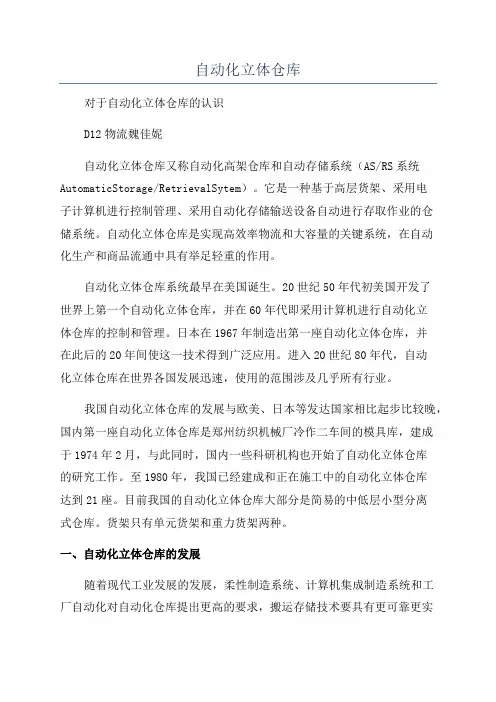
自动化立体仓库对于自动化立体仓库的认识D12物流魏佳妮自动化立体仓库又称自动化高架仓库和自动存储系统(AS/RS系统AutomaticStorage/RetrievalSytem)。
它是一种基于高层货架、采用电子计算机进行控制管理、采用自动化存储输送设备自动进行存取作业的仓储系统。
自动化立体仓库是实现高效率物流和大容量的关键系统,在自动化生产和商品流通中具有举足轻重的作用。
自动化立体仓库系统最早在美国诞生。
20世纪50年代初美国开发了世界上第一个自动化立体仓库,并在60年代即采用计算机进行自动化立体仓库的控制和管理。
日本在1967年制造出第一座自动化立体仓库,并在此后的20年间使这一技术得到广泛应用。
进入20世纪80年代,自动化立体仓库在世界各国发展迅速,使用的范围涉及几乎所有行业。
我国自动化立体仓库的发展与欧美、日本等发达国家相比起步比较晚,国内第一座自动化立体仓库是郑州纺织机械厂冷作二车间的模具库,建成于1974年2月,与此同时,国内一些科研机构也开始了自动化立体仓库的研究工作。
至1980年,我国已经建成和正在施工中的自动化立体仓库达到21座。
目前我国的自动化立体仓库大部分是简易的中低层小型分离式仓库。
货架只有单元货架和重力货架两种。
一、自动化立体仓库的发展随着现代工业发展的发展,柔性制造系统、计算机集成制造系统和工厂自动化对自动化仓库提出更高的要求,搬运存储技术要具有更可靠更实时的信息,工厂和仓库中的物流必须伴随着并行的信息流。
无线数据通信、条形码技术和数据采集越来越多的应用于自动化立体仓库系统。
在自动化立体仓库发展过程中,经历了自动化、集约化、集成化和智能化几个发展过程。
自动化时期主要在20世纪60到70年代,随着计算机技术的发展,自动化立体仓库得到了迅猛发展。
在1967到1977年10年中,日本建设超过了8000套自动化立体仓库系统。
集约化发展是伴随大规模生产需求而发展的。
其规模曾经发展到超过100个巷道,货位数超过20万个。
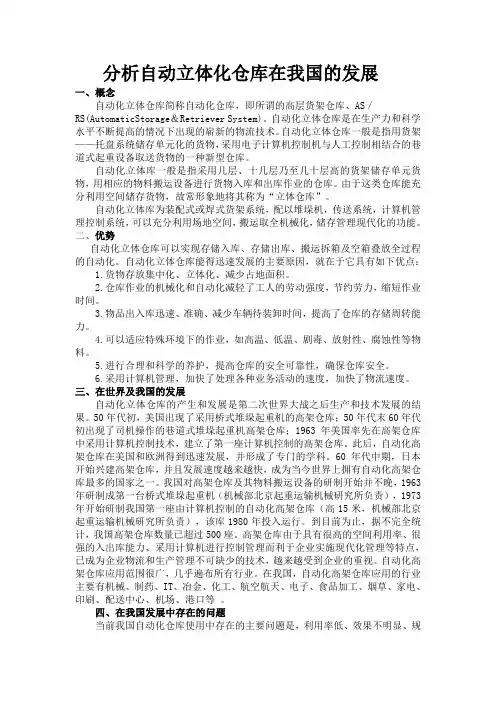
分析自动立体化仓库在我国的发展一、概念自动化立体仓库简称自动化仓库,即所谓的高层货架仓库、AS/RS(AutomaticStorage&Retriever System)。
自动化立体仓库是在生产力和科学水平不断提高的情况下出现的崭新的物流技术。
自动化立体仓库一般是指用货架——托盘系统储存单元化的货物,采用电子计算机控制机与人工控制相结合的巷道式起重设备取送货物的一种新型仓库。
自动化立体库一般是指采用几层、十几层乃至几十层高的货架储存单元货物,用相应的物料搬运设备进行货物入库和出库作业的仓库。
由于这类仓库能充分利用空间储存货物,故常形象地将其称为“立体仓库”。
自动化立体库为装配式或焊式货架系统,配以堆垛机,传送系统,计算机管理控制系统,可以充分利用场地空间,搬运取全机械化,储存管理现代化的功能。
二、优势自动化立体仓库可以实现存储入库、存储出库、搬运拆箱及空箱叠放全过程的自动化。
自动化立体仓库能得迅速发展的主要原因,就在于它具有如下优点:1.货物存放集中化、立体化、减少占地面积。
2.仓库作业的机械化和自动化减轻了工人的劳动强度,节约劳力,缩短作业时间。
3.物品出入库迅速、准确、减少车辆待装卸时间,提高了仓库的存储周转能力。
4.可以适应特殊环境下的作业,如高温、低温、剧毒、放射性、腐蚀性等物料。
5.进行合理和科学的养护,提高仓库的安全可靠性,确保仓库安全。
6.采用计算机管理,加快了处理各种业务活动的速度,加快了物流速度。
三、在世界及我国的发展自动化立体仓库的产生和发展是第二次世界大战之后生产和技术发展的结果。
50年代初,美国出现了采用桥式堆垛起重机的高架仓库;50年代末60年代初出现了司机操作的巷道式堆垛起重机高架仓库;1963年美国率先在高架仓库中采用计算机控制技术,建立了第一座计算机控制的高架仓库。
此后,自动化高架仓库在美国和欧洲得到迅速发展,并形成了专门的学科。
60年代中期,日本开始兴建高架仓库,并且发展速度越来越快,成为当今世界上拥有自动化高架仓库最多的国家之一。
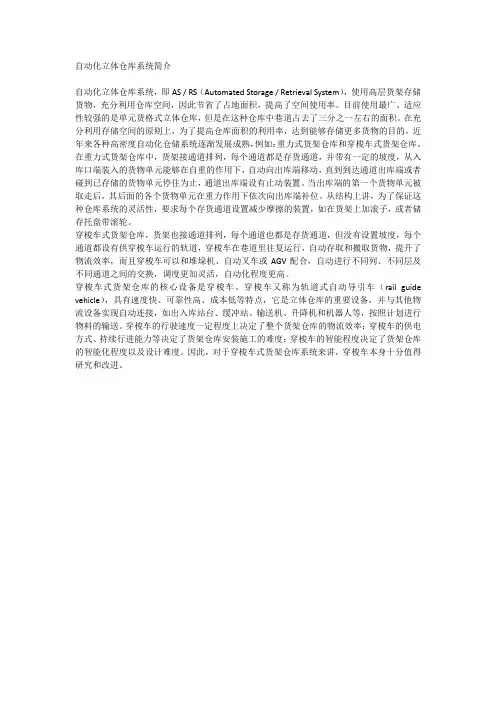
自动化立体仓库系统简介自动化立体仓库系统,即AS / RS(Automated Storage / Retrieval System),使用高层货架存储货物,充分利用仓库空间,因此节省了占地面积,提高了空间使用率。
目前使用最广、适应性较强的是单元货格式立体仓库,但是在这种仓库中巷道占去了三分之一左右的面积。
在充分利用存储空间的原则上,为了提高仓库面积的利用率,达到能够存储更多货物的目的,近年来各种高密度自动化仓储系统逐渐发展成熟,例如:重力式货架仓库和穿梭车式货架仓库。
在重力式货架仓库中,货架接通道排列,每个通道都是存货通道,并带有一定的坡度,从入库口端装入的货物单元能够在自重的作用下,自动向出库端移动,直到到达通道出库端或者碰到已存储的货物单元停住为止,通道出库端设有止动装置。
当出库端的第一个货物单元被取走后,其后面的各个货物单元在重力作用下依次向出库端补位。
从结构上讲,为了保证这种仓库系统的灵活性,要求每个存货通道设置减少摩擦的装置,如在货架上加滚子,或者储存托盘带滚轮。
穿梭车式货架仓库,货架也接通道排列,每个通道也都是存货通道,但没有设置坡度,每个通道都设有供穿梭车运行的轨道,穿梭车在巷道里往复运行,自动存取和搬取货物,提升了物流效率,而且穿梭车可以和堆垛机、自动叉车或AGV配合,自动进行不同列、不同层及不同通道之间的交换,调度更加灵活,自动化程度更高。
穿梭车式货架仓库的核心设备是穿梭车。
穿梭车又称为轨道式自动导引车(rail guide vehicle),具有速度快、可靠性高、成本低等特点,它是立体仓库的重要设备,并与其他物流设备实现自动连接,如出入库站台、缓冲站、输送机、升降机和机器人等,按照计划进行物料的输送。
穿梭车的行驶速度一定程度上决定了整个货架仓库的物流效率;穿梭车的供电方式、持续行进能力等决定了货架仓库安装施工的难度;穿梭车的智能程度决定了货架仓库的智能化程度以及设计难度。
因此,对于穿梭车式货架仓库系统来讲,穿梭车本身十分值得研究和改进。
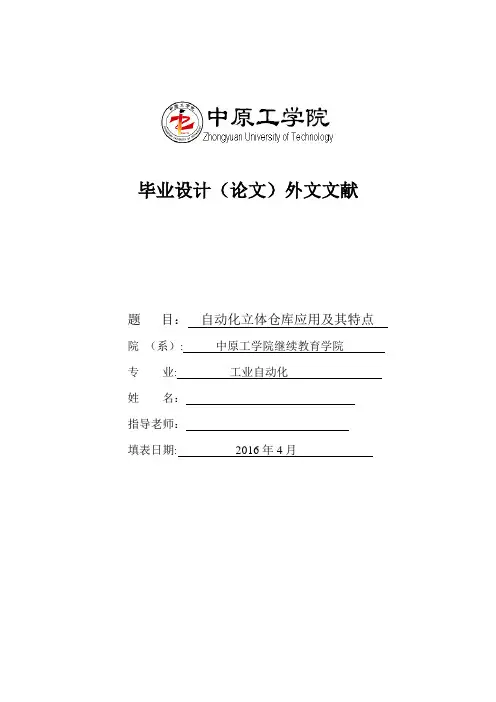
毕业设计(论文)外文文献题目:自动化立体仓库应用及其特点院(系): 中原工学院继续教育学院专业: 工业自动化姓名:指导老师:填表日期: 2016年4月Application of Automatic Warehouse and its characteristics overhead storage for short Top shelf storage Generally refers to the use of layers,a dozen or even several-storey layer shelf storage unit goods,material handling equipment with the corresponding goods inbound and outbound warehouse operations。
As such storage can make full use of space for storage,Guchang image to be known as the "Warehouse。
”1.1Automatic WarehouseHigh overhead for short shelf storage warehouse. Generally refers to the use of layers,a dozen or even several-storey layer shelf storage unit goods, material handling equipment with the corresponding goods inbound and outbound warehouse operations. As such storage can make full use of space for storage,Guchang image to be known as the ”Warehouse。
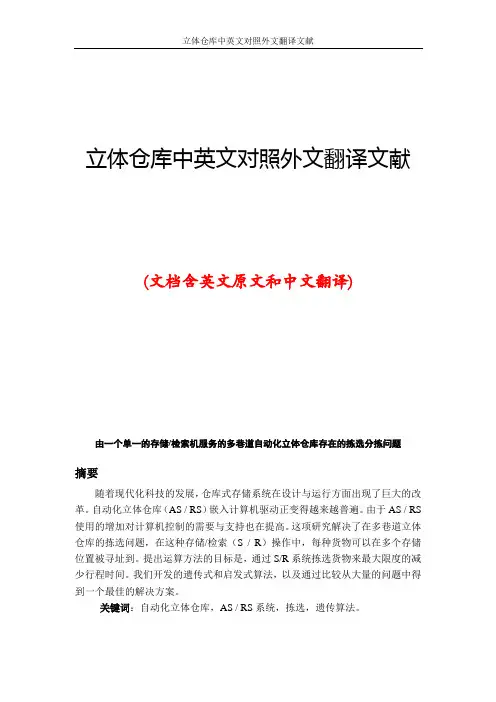
立体仓库中英文对照外文翻译文献(文档含英文原文和中文翻译)由一个单一的存储/检索机服务的多巷道自动化立体仓库存在的拣选分拣问题摘要随着现代化科技的发展,仓库式存储系统在设计与运行方面出现了巨大的改革。
自动化立体仓库(AS / RS)嵌入计算机驱动正变得越来越普遍。
由于AS / RS 使用的增加对计算机控制的需要与支持也在提高。
这项研究解决了在多巷道立体仓库的拣选问题,在这种存储/检索(S / R)操作中,每种货物可以在多个存储位置被寻址到。
提出运算方法的目标是,通过S/R系统拣选货物来最大限度的减少行程时间。
我们开发的遗传式和启发式算法,以及通过比较从大量的问题中得到一个最佳的解决方案。
关键词:自动化立体仓库,AS / RS系统,拣选,遗传算法。
1.言在现今的生产环境中,库存等级保持低于过去。
那是因为这种较小的存储系统不仅降低库存量还增加了拣选货物的速度。
自动化立体仓库(AS / RS),一方面通过提供快速响应,来达到高操作效率;另一方面它还有助于运作方面的系统响应时间,减少的拣选完成的总行程时间。
因此,它常被用于制造业、储存仓库和分配设备等行业中。
拣选是仓库检索功能的基本组成部分。
它的主要目的是,在预先指定的地点中选择适当数量的货物以满足客户拣选要求。
虽然拣选操作仅仅是物体在仓储中装卸操作之一,但它却是“最耗时间和花费最大的仓储功能。
许多情形下,仓储盈利的高低就在于是否能将拣选操作运行处理好”。
(Bozer和White)Ratliff和Rosenthal,他们关于自动化立体仓库系统(AS/RS)的拣选问题进行的研究,发明了基图算法,在阶梯式布局中选取最短的访问路径。
Roodbergen 和de Koster 拓展了Ratliff 和Rosenthal算法。
他们认为,在平行巷道拣选问题上,应该穿越巷道末端和中间端进行拣选,就此他们发明了一种动态的规划算法解决这问题。
就此Van den Berg 和Gademann发明了一种运输模型(TP),它是对于指定的存储和卸载进行测算的仪器。

立体仓库中英文对照外文翻译文献(文档含英文原文和中文翻译)由一个单一的存储/检索机服务的多巷道自动化立体仓库存在的拣选分拣问题摘要随着现代化科技的发展,仓库式存储系统在设计与运行方面出现了巨大的改革。
自动化立体仓库(AS / RS)嵌入计算机驱动正变得越来越普遍。
由于AS / RS 使用的增加对计算机控制的需要与支持也在提高。
这项研究解决了在多巷道立体仓库的拣选问题,在这种存储/检索(S / R)操作中,每种货物可以在多个存储位置被寻址到。
提出运算方法的目标是,通过S/R系统拣选货物来最大限度的减少行程时间。
我们开发的遗传式和启发式算法,以及通过比较从大量的问题中得到一个最佳的解决方案。
关键词:自动化立体仓库,AS / RS系统,拣选,遗传算法。
1.言在现今的生产环境中,库存等级保持低于过去。
那是因为这种较小的存储系统不仅降低库存量还增加了拣选货物的速度。
自动化立体仓库(AS / RS),一方面通过提供快速响应,来达到高操作效率;另一方面它还有助于运作方面的系统响应时间,减少的拣选完成的总行程时间。
因此,它常被用于制造业、储存仓库和分配设备等行业中。
拣选是仓库检索功能的基本组成部分。
它的主要目的是,在预先指定的地点中选择适当数量的货物以满足客户拣选要求。
虽然拣选操作仅仅是物体在仓储中装卸操作之一,但它却是“最耗时间和花费最大的仓储功能。
许多情形下,仓储盈利的高低就在于是否能将拣选操作运行处理好”。
(Bozer和White)Ratliff和Rosenthal,他们关于自动化立体仓库系统(AS/RS)的拣选问题进行的研究,发明了基图算法,在阶梯式布局中选取最短的访问路径。
Roodbergen 和de Koster 拓展了Ratliff 和Rosenthal算法。
他们认为,在平行巷道拣选问题上,应该穿越巷道末端和中间端进行拣选,就此他们发明了一种动态的规划算法解决这问题。
就此Van den Berg 和Gademann发明了一种运输模型(TP),它是对于指定的存储和卸载进行测算的仪器。

自动化立体库简介自动化立体库(Automated Storage and Retrieval System,简称AS/RS)是一种高效、智能的仓储设备,利用先进的技术和自动化系统,实现对物料的快速存储和检索。
它通过将货物垂直存放在垂直高度可调的货架上,并利用自动化设备进行货物的存储和检索,大大提高了仓储效率和空间利用率。
自动化立体库通常由货架系统、输送设备、控制系统和管理软件组成。
货架系统是AS/RS的核心部份,它由垂直立柱、水平梁、货架板等组成,可以根据货物的尺寸和分量进行调整。
输送设备包括堆垛机、输送线、升降机等,用于将货物从入库区域转移到存储区域或者从存储区域取出。
控制系统负责监控和控制整个系统的运行,确保系统的稳定和安全。
管理软件则用于对仓库进行管理和优化,包括库存管理、定单管理、作业调度等功能。
自动化立体库具有多种优势。
首先,它可以大大提高仓储效率。
由于采用自动化设备进行存储和检索,减少了人工操作的时间和错误率,大大提高了作业效率。
其次,它可以节省仓储空间。
由于货物垂直存放,立体库可以利用仓库的垂直空间,提高空间利用率。
此外,自动化立体库还具有安全、可靠、灵便等特点,适合于各种类型和规模的仓库。
自动化立体库在各个行业都有广泛的应用。
在创造业中,它可以用于零部件的存储和供应链管理;在电商行业中,它可以用于商品的存储和分拣;在医药行业中,它可以用于药品的存储和配送等。
无论是大型企业还是中小型企业,都可以根据自身的需求选择适合的自动化立体库系统。
总之,自动化立体库是一种高效、智能的仓储设备,通过利用先进的技术和自动化系统,实现对物料的快速存储和检索。
它可以大大提高仓储效率和空间利用率,适合于各种行业和规模的仓库。
随着科技的不断进步,自动化立体库将在未来发展中扮演越来越重要的角色。

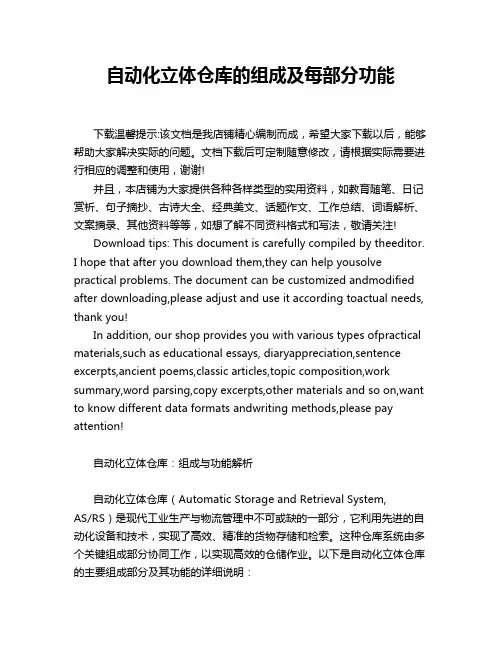
自动化立体仓库的组成及每部分功能下载温馨提示:该文档是我店铺精心编制而成,希望大家下载以后,能够帮助大家解决实际的问题。
文档下载后可定制随意修改,请根据实际需要进行相应的调整和使用,谢谢!并且,本店铺为大家提供各种各样类型的实用资料,如教育随笔、日记赏析、句子摘抄、古诗大全、经典美文、话题作文、工作总结、词语解析、文案摘录、其他资料等等,如想了解不同资料格式和写法,敬请关注!Download tips: This document is carefully compiled by theeditor.I hope that after you download them,they can help yousolve practical problems. The document can be customized andmodified after downloading,please adjust and use it according toactual needs, thank you!In addition, our shop provides you with various types ofpractical materials,such as educational essays, diaryappreciation,sentence excerpts,ancient poems,classic articles,topic composition,work summary,word parsing,copy excerpts,other materials and so on,want to know different data formats andwriting methods,please pay attention!自动化立体仓库:组成与功能解析自动化立体仓库(Automatic Storage and Retrieval System,AS/RS)是现代工业生产与物流管理中不可或缺的一部分,它利用先进的自动化设备和技术,实现了高效、精准的货物存储和检索。
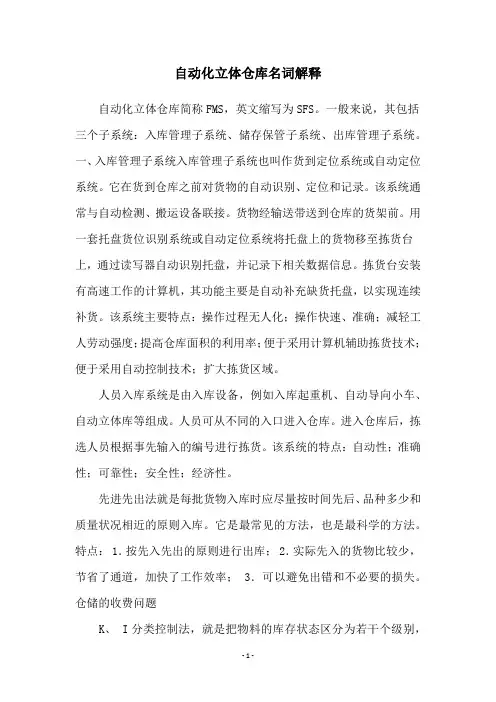
自动化立体仓库名词解释自动化立体仓库简称FMS,英文缩写为SFS。
一般来说,其包括三个子系统:入库管理子系统、储存保管子系统、出库管理子系统。
一、入库管理子系统入库管理子系统也叫作货到定位系统或自动定位系统。
它在货到仓库之前对货物的自动识别、定位和记录。
该系统通常与自动检测、搬运设备联接。
货物经输送带送到仓库的货架前。
用一套托盘货位识别系统或自动定位系统将托盘上的货物移至拣货台上,通过读写器自动识别托盘,并记录下相关数据信息。
拣货台安装有高速工作的计算机,其功能主要是自动补充缺货托盘,以实现连续补货。
该系统主要特点:操作过程无人化;操作快速、准确;减轻工人劳动强度;提高仓库面积的利用率;便于采用计算机辅助拣货技术;便于采用自动控制技术;扩大拣货区域。
人员入库系统是由入库设备,例如入库起重机、自动导向小车、自动立体库等组成。
人员可从不同的入口进入仓库。
进入仓库后,拣选人员根据事先输入的编号进行拣货。
该系统的特点:自动性;准确性;可靠性;安全性;经济性。
先进先出法就是每批货物入库时应尽量按时间先后、品种多少和质量状况相近的原则入库。
它是最常见的方法,也是最科学的方法。
特点: 1.按先入先出的原则进行出库; 2.实际先入的货物比较少,节省了通道,加快了工作效率; 3.可以避免出错和不必要的损失。
仓储的收费问题K、 I分类控制法,就是把物料的库存状态区分为若干个级别,如A类物料为即将订购的产品, B类物料为周转储备产品, C类物料为已订购产品。
D类物料为非订购产品,由仓库内的储存模式决定这些物料的优先出库顺序,直至成为非订购产品。
这样,一方面可使各个级别的库存得到及时补充,另一方面又可避免因混放造成的差错。
二、储存保管子系统储存保管子系统也称为货位管理系统,它是指按照仓库规划设计的要求,对仓库内的货架、托盘、箱子等储存设施及场地所进行的分区、编号和管理。
出库管理子系统包括以下几个步骤: 1.自动打印出库单据; 2.确认出库,并打印发货单; 3.确认出库; 4.拣选出库; 5.手工盘点。

物流技术装备及设施术语1. 仓库 warehouse ['wεəhaus]2. 库房 storehouse ['stɔ:haus]3. 自动化仓库 automatic warehouse[,ɔ:tə'mætik]4. 立体仓库 stereoscopic warehouse [,steriəu'skɔpik]5. 虚拟仓库 virtual warehouse ['və:tʃuəl] 6. 保税仓库 boned warehouse [bəund] 7. 出口监管仓库 export supervised warehouse [ik'spɔ:t] ['sju:pəvaizd]8. 海关监管货物 cargo under customer’s supervision ['kʌstəmə] [,sju:pə'viʒən]9. 冷藏区 chill space [tʃil] [speis]10. 冷冻区 freeze space [fri:z]11. 控湿储存区 humidity controlled space [hju:'midəti] [kən'trəuld]12. 温度可控区 temperature controlled space ['tempəritʃə]13. 收货区 receiving space [ri'si:viŋ]14. 发货区 shipping space15. 料棚 goods shed [ʃed]16. 货场 goods yard [jɑ:d]17. 货架 goods shelf [ʃelf]18. 托盘 pallet ['pælit]19. 铲运车/叉车 fork lift truck20. 输送机 conveyor [kən'veiə]21. 自动导引车 automatic guided vehicle (AGV) ['ɡaidid] ['viːɪk(ə)l]22. 箱式车 box car23. 集装箱 container [kən'teinə]24. 换算箱 twenty-feet equivalent unit (TEU) [i'kwivələnt] ['ju:nit]25. 特种货物集装箱 specific cargo container [spi'sifik]26. 全集装箱船 full container ship27. 铁路集装箱场 railway container yard28. 公路集装箱中转站 inland container depot 29. 集装箱货运站 container freight station (CFS)30. 集装箱码头 container terminal ['tə:minəl] 31. 国际铁路联运 international through railway transport [,intə'næʃənəl] [θru:]32. 国际多式联运 international multimodal transport [,mʌlti'məudəl]33. 大陆桥运输 land bridge transport34. 班轮运输 liner transport35. 租船运输 shipping by chartering['tʃɑ:təriŋ]36. 船务代理 shipping agency ['eidʒənsi] 37. 国际货运代理 international freight forwarding agent ['eidʒənt]38. 理货 tally ['tæli]39. 国际货物运输保险 international transportation cargo insurance [in'ʃuərəns] 40. 报关 customs declaration ['kʌstəmz] [,deklə'reiʃən]41. 报关行 customs broker ['brəukə] 42. 进出口商品检验 commodity inspection [kə'mɔditi] [in'spekʃən]1. agent ['eidʒənt]n. 代理人,代理商;药剂;特工adj. 代理的vt. 由…作中介;由…代理2. shipping ['ʃipiŋ]n. [船] 船舶,船舶吨数;海运;运送v. 运送,乘船(ship的ing形式)3. truck [trʌk]n. 卡车;交易;手推车adj. (美)运货汽车的vt. 交易;以卡车运输vi. 驾驶卡车;以物易物4. warehouse ['wεəhaus, 'wεəhauz, -haus]n. 仓库;货栈;大商店vt. 储入仓库;以他人名义购进(股票)5. storehouse ['stɔ:haus]n. 仓库,贮藏库;宝库6. automatic [,ɔ:tə'mætik]n. 自动机械;自动手枪adj. 自动的;无意识的;必然的7. stereoscopic [,steriəu'skɔpik, ,stiə-]adj. 立体的;体视镜的;有立体感的8. boned [bəund]adj. 骨骼的;去掉骨头的;用骨架撑起的;施过骨粉料的;去骨的9. export [ik'spɔ:t, 'eks-, 'ekspɔ:t]n. 输出,出口;出口商品vt. 输出,出口vi. 输出物资10. supervised ['sju:pəvaizd]v. 监督(supervise的过去式和过去分词);指导adj. 有监督的11. customer ['kʌstəmə]n. 顾客;家伙12. supervision [,sju:pə'viʒən]n. 监督,管理13. chill [tʃil]n. 寒冷;寒意;寒心vt. 冷冻,冷藏;使寒心;使感到冷adj. 寒冷的;冷漠的;扫兴的vi. 冷藏;变冷14. space [speis]n. 空间;太空;距离vt. 隔开vi. 留间隔15. freeze [fri:z]n. 冻结;凝固vt. 使…冻住;使…结冰vi. 冻结;冷冻;僵硬16. humidity [hju:'midəti]n. [气象] 湿度;湿气17. controlled [kən'trəuld]v. 控制;约束(control的过去式);指挥adj. 受控制的;受约束的;克制的18. temperature ['tempəritʃə]n. 温度19. receiving [ri'si:viŋ]n. 接受v. 接收(receive的ing形式)adj. 接受的20. shed [ʃed]n. 小屋,棚;分水岭vt. 流出;摆脱;散发;倾吐vi. 流出;脱落;散布21. yard [jɑ:d]n. 院子;码(英制中丈量长度单位,1码=3英尺);庭院;帆桁vt. 把…关进或围在畜栏里22. shelf [ʃelf]n. 架子;搁板;搁板状物23. pallet ['pælit]n. 托盘,货板;简陋小床;调色板24. fork [fɔ:k]n. 叉;餐叉;耙vt. 叉起;使成叉状vi. 分叉;分歧25. lift [lift]n. 电梯;举起;起重机;搭车vt. 举起;提升;鼓舞;空运;抄袭vi. 消散;升起;耸立26. conveyor [kən'veiə]n. 输送机,[机] 传送机;传送带;运送者,传播者27. guided ['ɡaidid]v. 指导(guide的过去分词)adj. 有指导的;有向导的28. vehicle ['viːɪk(ə)l]n. [车辆] 车辆;工具;交通工具;运载工具;传播媒介;媒介物29. equivalent [i'kwivələnt]n. 等价物,相等物adj. 等价的,相等的;同意义的30. unit ['ju:nit]n. 单位,单元;装置;[军] 部队;部件31. specific [spi'sifik]n. 特性;细节;特效药adj. 特殊的,特定的;明确的;详细的;[药] 具有特效的32. railway ['reilwei]n. (英)铁路;轨道;铁道部门vi. 乘火车旅行33. inland ['inlənd, -lænd]n. 内地;内陆adj. 内陆的;内地的;国内的adv. 在内地;向内地;向内陆;在内陆34. station ['steiʃən]n. 站;驻地;地位;身分vt. 配置;安置;驻扎35. terminal ['tə:minəl]n. 末端;终点;终端机;极限adj. 末端的;终点的;晚期的36. multimodal [,mʌlti'məudəl]adj. [统计] 多峰的;多模式的n. 多峰37. chartering ['tʃɑ:təriŋ]n. 租用v. 给予…特权;包租(charter的ing形式)38. agency ['eidʒənsi]n. 代理,中介;代理处,经销处39. tally ['tæli]n. 计数器;标签;记账vi. 一致;记分vt. 使符合;计算;记录40. insurance [in'ʃuərəns]n. 保险;保险费;保险契约;赔偿金41. customs ['kʌstəmz]n. 海关;风俗(custom的复数);习惯;关税42. declaration [,deklə'reiʃən]n. (纳税品等的)申报;宣布;公告;申诉书43. broker ['brəukə]n. 经纪人,掮客vt. 以中间人等身分安排...vi. 作为权力经纪人进行谈判44. commodity [kə'mɔditi]n. 商品,货物;日用品。
关于自动化立体仓库使用双货叉问题的探讨-An Analysis Of Dual Shuttle Automated Storage/Retrieval SystemsAn Analysis Of Dual ShuttleAutomated Storage/Retrieval SystemsAdhinarayan KeserlaBrett A. PetersAugust 1, 1994This working paper is not to be copied, quoted, or cited without the permission of the authors. Address correspondence to Brett A. Peters, Dept. of Industrial Engineering, Texas A&M University, College Station, TX 77843-3131 or email to bpeters@AbstractThis paper addresses the throughput improvement possible with the use of a dual shuttle automated storage and retrieval system. With the use of such a system, travel between time in a dual command cycle is virtually eliminated resulting in a large throughput improvement. The dual shuttle system is then extended to perform an equivalent of two dual commands in one cycle in a quadruple command mode (QC). A heuristic that sequences retrievals to minimize travel time in QC mode is developed. Monte Carlo simulation results are provided for evaluating the heuristic's performance and show that it performs well, achieving large throughput improvements compared with that of the dual command cycle operating under the nearest neighbor retrieval sequencing heuristic.Keywords:Automated Storage/Retrieval Systems Design; Automated Storage/Retrieval Systems Operation; Material Handling Systems; Performance Modeling and AnalysisIntroductionAutomated storage/retrieval systems (AS/RS) are widely used in warehousing and manufacturing applications. A typical unit load AS/RS consists of storage racks, S/R machines, link conveyors, and input/output (I/O) stations. An important system performance measure is the throughput capacity of the system. The throughput capacity for a single aisle is the inverse of the mean transaction time, which is the expected amount of time required for the S/R machine to store and/or retrieve a unit load. The service time for a transaction includes both S/R machine travel time and pickup/deposit time. This time typically depends on the configuration of the storage rack and the S/R machine specifications.Han et al. [2] improved the throughput capacity of the AS/RS through sequencing retrievals. Intelligently sequencing the retrievals can reduce unproductive travel between time when the S/R machine is traveling empty and thereby increase the throughput. They develop an expression for the maximum possible improvement in throughput if travel between is eliminated for an AS/RS that is throughput bound and operates in dual command mode. In essence, this means that if the S/R machine travels in a single command path but performs both a storage and a retrieval operation, the above throughput improvement could be obtained.In this paper, we analyze an alternative design of the S/R machine that has two shuttles instead ofone as in a regular AS/RS. The new design eliminates the travel between the storage and retrieval points and performs both a storage and a retrieval at the point of retrieval, thereby achieving the maximum throughput increase calculated by Han et al. [3].The dual shuttle AS/RS is a new design aimed at improving S/R machine performance. most studies on AS/RS systems have been based on a single shuttle design. In our analysis of the dual shuttle AS/RS performance, we build upon these previous research results.Alternative S/R Machine DesignA typical unit-load AS/RS has an S/R machine operating in each aisle of the system. The S/R machine has a mast which is supported at the floor and the ceiling and travels horizontally within the aisle. Connected to this mast is a shuttle mechanism that carries the unit load and moves vertically up and down the mast. The shuttle mechanism also transfers loads in and out of storage locations in the rack. Figure 1 provides an illustration of the single shuttle S/R machine.Figure 1. Single Shuttle S/R Machine DesignA typical single shuttle AS/RS can perform a single command cycle or a dual command cycle. A single command cycle consists of either a storage or a retrieval. For a storage, the time consists of the time to pickup the load at the I/O point, travel to the storage point, deposit the load at that point, and return to the I/O point. The time for a retrieval is developed similarly.A dual command cycle involves both a storage and a retrieval in the same cycle. The cycle time involves the time to pickup the load at the I/O point, travel to the storage location, place the load in the rack, travel empty to the retrieval location, retrieve a load, return to the I/O point, and deposit the load at the I/O point.If we critically analyze the dual command cycle of the S/R machine (shown by the solid line in Figure 2), a potential open location for a future storage is created when a retrieval is performed. Furthermore, if both a retrieval and a storage are performed at the same point, the travel between time (TB) is eliminated, and the travel time will be equal to the single command travel time. With the existing AS/RS design, this mode of operation is not possible; therefore, an alternative to the S/R machine, a dual shuttle R/S machine, is proposed.Figure 2. Dual Command Travel Paths of S/R and R/S MachinesR/S Machine OperationConsider an S/R machine with two shuttle mechanisms instead of one. This new S/R machine could now carry two loads simultaneously. Each shuttle mechanism could operate independently of the other, so that individual loads can still be stored and retrieved. An illustration of the dual shuttle S/R machine is shown in Figure 3. This new S/R machine would operate as described below.Figure 3. Dual Shuttle S/R Machine DesignThe S/R machine picks up the item to be stored from the I/O point, loads it into the first shuttle, and moves to the retrieval location. After reaching the retrieval location, the second shuttle is positioned to pickup the item to be retrieved. After retrieval, the S/R machine positions the first shuttle and deposits the load. The S/R machine then returns to the I/O point. The operation can easily be seen as a single command operation plus a small travel time for repositioning the S/R machine between the retrieval and storage (as well as the additional pickup and deposit time associated with the second load). Therefore, the S/R machine now operates as an R/S machine performing a retrieval first then a storage in a dual command cycle.Since the R/S machine has two shuttles, the position of the shuttles has a role in the operation ofthe system. With two shuttles, the R/S machine is able to perform a dual command cycle at one location in the rack. This operation is accomplished by first retrieving the load onto the empty shuttle, transferring the second shuttle into position, and storing the load into the empty location in the rack. However, the choice of shuttle configuration does not impact the analysis in this paper. To perform these operations, the R/S machine must move the second shuttle into position after the first shuttle has completed the retrieval. Due to the small distance involved, the R/S machine will use a slower creep speed for positioning, but this travel time is generally small. Furthermore, an amount of creep time is usually included in the pickup and deposit time to account for this required positioning. A second design characteristic is that additional clearance beyond the first and last row and column of the rack must be provided for overtravel of the R/S machine to accommodate both shuttle mechanisms.Throughput ImprovementTo estimate the throughput improvement by the dual shuttle system over existing designs, we use the expressions for single command and dual command cycle times developed by Bozer and White [1] and the tabulated values for the nearest neighbor heuristic from Han et al. [4]. In developing the expressions, the authors in [1] and [4] made several assumptions. The same assumptions hold for the new design and include the following.1. The rack is considered to be a continuous rectangular pick face where the I/O point is located at the lower left-hand corner of the rack.2. The rack length and height, as well as the S/R machine velocity in the horizontal and vertical directions, are known.3. The S/R machine travels simultaneously in the horizontal and vertical directions. In calculating the travel time, constant velocities are used for horizontal and vertical travel. Acceleration and deceleration effects are implicitly accounted for in either a reduced top speed or an increased pickup and deposit time. A creep speed is used for repositioning the dual shuttle.4. Pickup and deposit times associated with load handling are assumed constant and, therefore, these could be easily added into the cycle time expressions.5.The S/R machine operates either on a single or dual command basis, i.e., multiple stops in the aisle are not allowed. (This assumption is later relaxed for the new R/S machine to perform a quadruple command cycle.)6. For the nearest neighbor heuristic, a block of n retrievals is available for sequencing and there are m initial open locations in the rack face.Dual Shuttle S/R SystemsThe new design of the S/R machine has two shuttles and therefore could be operated as a dual shuttle system: carrying two loads and depositing them, retrieving two loads, and returning to the I/O point to deliver them as shown in Figure 4. The above operation can be performed by storing and retrieving the loads at four different locations. Therefore, the travel time would consist of the time for a single command travel plus three travel between times. To more efficiently perform the 4 operations, a retrieval and storage performed at one location is interspersed with a dual command operation. This mode of operation, termed the quadruple command (QC) cycle, eliminates one travel between and is more efficient than the previous mode mentioned above (see Figure 5). The QC cycle can be performed with storages at randomized locations and retrievals processed in a first-come-first-served (FCFS) manner. However, by intelligently sequencing the retrieval list, the travel time in performing the four operations can be significantly reduced. Thistype of analysis was used by Han et al. [4] to improve the throughput of a single load AS/RS. In our paper, we build on the results of their analysis. The notation and the assumptions mentioned in section 2.2. still hold, except that multiple stops of the S/R machine are now allowed.Figure 4. S/R Machine Path Performing Four Operations At Four Locations.Figure 5. S/R Machine Path Performing Four Operations At Three Locations.ConclusionsThis paper performs an analysis of dual shuttle automated storage and retrieval systems. Several contributions have been made including the following.1.Throughput improvements in the range of 40-45% can be obtained using the quadruple command cycle relative to dual command cycles with a single shuttle system.2.With the dual shuttle design, travel between is virtually eliminated for a dual command cycle. The dual shuttle system shows promise for situations requiring high throughput. The main disadvantage with the new design is the extra cost of the S/R machine. An economic evaluation is needed to determine if it is appropriate for a particular situation. However, based on throughput performance, the dual shuttle design appears promising.The concept of dual shuttle systems can also be extended to other material handling systems. Furthermore, research is needed to consider other storage strategies, such as class based storage policies, to examine their impact on throughput in conjunction with the dual shuttle design. This paper provides a framework for analyzing dual shuttle AS/RS, and it provides a foundation for other material handling research related to this concept.References[1] Bozer, Y.A. and J.A. White, "Travel-Time Models for Automated Storage/Retrieval Systems," IIE Transactions, V ol. 16 , No. 4, 1984, 329-338.[2] Elsayed, E.A. and O.I. Unal, "Order Batching Algorithms and Travel Time Estimation for Automated Storage/Retrieval Systems," International Journal of Production Research, V ol. 27, No. 7, 1989, 1097-1114.[3] Han, M.H., L.F. McGinnis, J.S. Shieh, and J.A. White, "On Sequencing Retrievals In An Automated Storage/Retrieval System," IIE Transactions, March 1987, 56-66.。